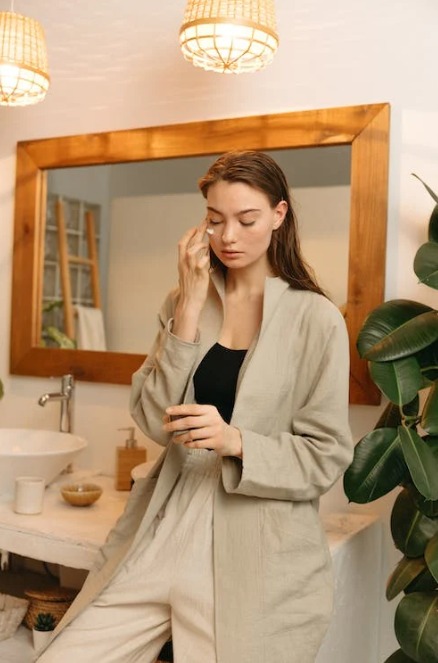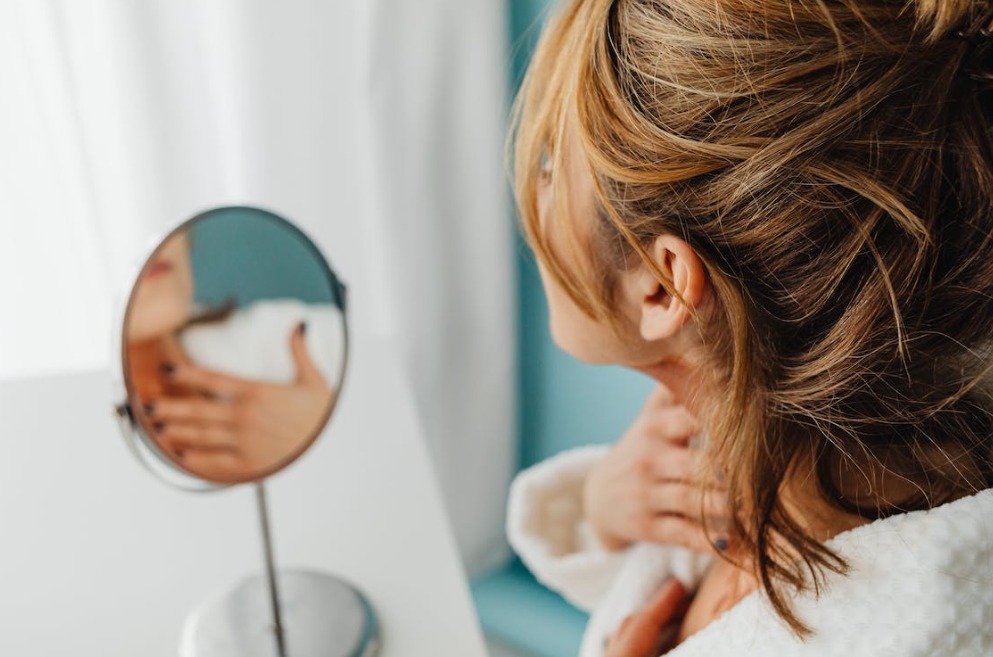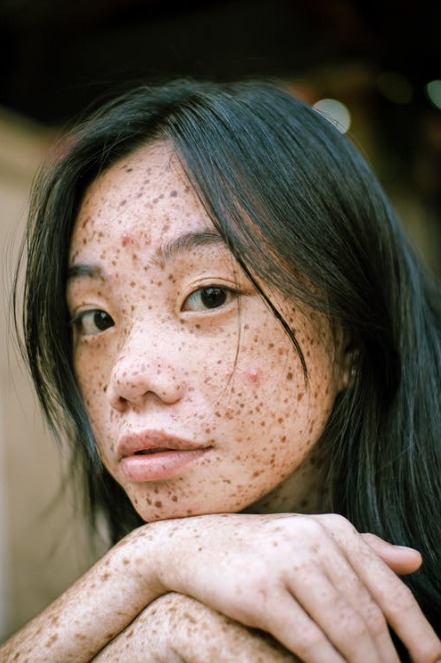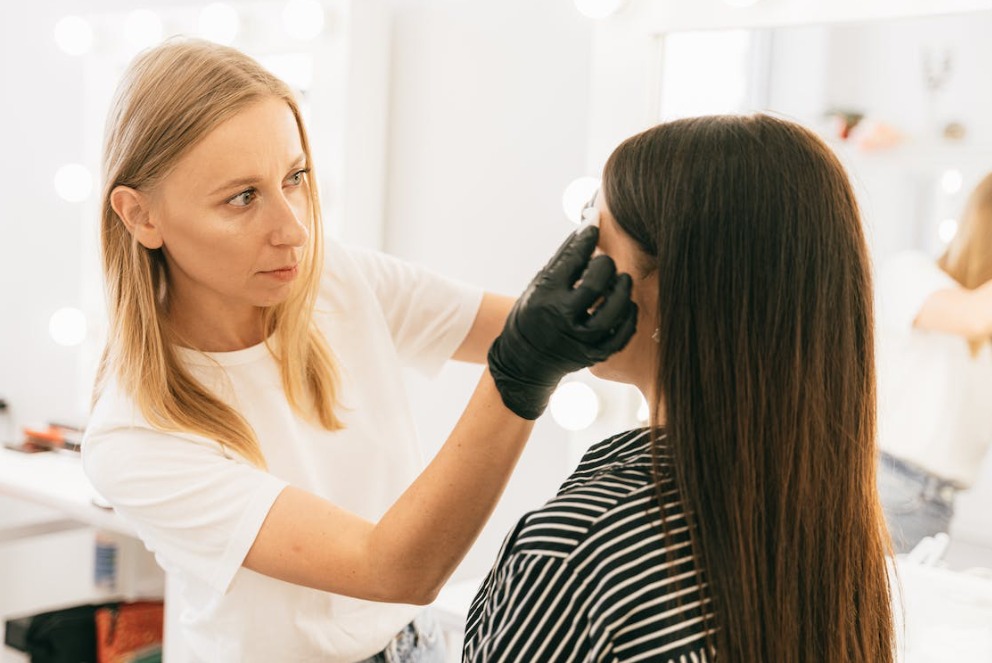Many people avoid sun exposure because they are afraid of sunspots appearing on their skin as brown spots. One may probably be considering how to get rid of sunspots right now. Not to worry! We have got your back. While sunspots can be challenging to hide if you don’t wear makeup, these brown, flat patches are not dangerous. If you’re looking for the finest methods to remove sunspots, this post is for you. We’ve brought together the root cause of sunspots, a few all-natural cures, and the best ways to get rid of them in this article. Look it up!
What Are Sunspots? What Causes Them?
Sunspots are flat, brown spots on our skin. They are solar lentigines, which can also be known as hyperpigmented skin blemishes. Long-term sun exposure may be the cause of these skin discolorations. Sunspots are caused by the multiplication of pigment cells (melanocytes) due to the sun’s strong ultraviolet radiation. Tyrosinase, an enzyme involved in the formation of melanin, can become overactive and lead to irregular melanocyte activity, which can result in sunspots. Additionally, inherited issues may contribute to these patches in some individuals. Any area of your body that is exposed to the sun can develop them. Your cheekbones, nose, upper lip, ears, arms, and hands might get affected.
What Are the Best Ways to Treat Sunspots?
There are multiple ways to treat sunspots and they can be broadly classified as home remedies and clinical treatments. You can try out home remedies depending on the severity of your sunspots and can reach out to a dermatologist if none of them work. Also, in case of any skin irritation, blistering, or uneven spots, seek medical help immediately.
Now, let’s check out some effective home remedies that may help you. Do you still have any memory of your mother’s carefully chosen face packs and remedies? The following points may take you down memory lane.
Home Remedies for Sunspots

1. Aloe vera
Fresh aloe vera gel or aloe juice can be beneficial for treating sunspots. Apply the aloe gel you’ve extracted from the leaf to the affected region. After 30 minutes, wash it off with water. Practice this daily. Natural healing elements found in aloe vera brighten dark spots and sun-damaged skin. It enhances skin quality and helps with skin regeneration. Aloe vera also has antityrosinase activity, which aids in sunspot removal. Additionally, it contains the active ingredients aloesin and aloin, which assist to reduce hyperpigmentation and sunspots.
2. Lemon
Lemons have bleaching qualities that could help lessen the visibility of sunspots. These can also aid in giving you a smooth and glowing appearance. To get rid of sun spots, you’ll require a lemon, a cotton ball, and 1/4 cup of water. Extract the juice from the fresh lemons. Apply it on the skin and keep it for 20 to 30 minutes. Rinse it off with cool water. After patting your face dry, moisturize well.
You can even use lemon juice in the form of a scrub. Combine one tablespoon of sugar and one tablespoon of lemon juice. Apply this mixture to the sunspots as a scrub. Scrub for 1-2 minutes and then leave the mixture on for around 10 minutes. Rinse with water to wash it off. Use the easy cure of lemon juice every day for great results. Try using the lemon-sugar scrub two to three times each week for the best results.
Caution: Lemon juice that has not been diluted is quite acidic and may harm skin, especially if it is a sensitive skin type.
3. Apple Cider Vinegar
Sunspots and other skin issues can benefit from using apple cider vinegar. ACV’s acetic acid has the potential to reduce melanin deposition. As a result, it might lessen sunspots. Here is an easy way to use this miraculous ingredient for benefitting your skin.
Mix 1 teaspoon of honey, 4 tablespoons of water, and 1 tablespoon of apple cider vinegar. Apply the mixture to the skin. Keep it at least for 10 minutes and then wash it off with water. For better and quicker results, add some orange juice to this mixture. To get the best benefits, perform this once every day. Sunspots and other skin issues can benefit from using apple cider vinegar. ACV’s acetic acid has the potential to reduce melanin deposition. As a result, it might lessen sunspots.
4. Green tea
It is renowned for being a potent source of antioxidants that combat tanning and blemishes on the skin. Additionally, it depigments the skin, which could be used to cure sunspots. Use it in the following manner for targeting sunspots.
Grab a cup of hot water and a green tea bag. For ten minutes, steep the tea bag in a cup of water. Remove the hot tea bag from the cup and let it cool down. Place the tea bag on the affected region after allowing it to cool. Once or twice a day, perform this.
5. Castor oil
A few drops of castor oil can help you deal better with hyperpigmentation. To attain the best results, cover the injured area with oil, and massage it for a while. Before rinsing it off, let it sit for at least an hour. Do this once or twice per day. Since castor oil contains the necessary fatty acids, it deeply nourishes your skin. Additionally, it aids in fading sun spots.
6. Besan (Gram Flour)
Besan is another age-old remedy that can help with sunspots. Use it in the given manner and you can bid adieu to hyperpigmented and dull skin. Add 2 tablespoons of besan, 1 teaspoon each of milk, lemon juice, and turmeric powder. By combining all the components, create a paste. Apply this pack all over your face, and leave it on for 15 minutes. Utilize cool water to rinse it off. If you have a dairy allergy, substitute rose water for milk. Do this a couple of times a week. Besan exfoliates the skin, lightens the skin tone, and decreases tan. Lemon brightens your skin, while milk includes lactic acid, which exfoliates the skin.
7. Buttermilk
Buttermilk has a calming effect on the skin. Additionally, a bleaching effect is said to exist, which could assist in reducing sunspots. Take a cotton ball and 1-2 teaspoons of buttermilk. Simply soak the cotton ball in a cup of buttermilk, then massage the affected region with the cotton ball. After letting it sit for ten minutes, rinse it off. To benefit, repeat this process twice daily. However, there has not been enough research to confirm the same.
8. Papaya pulp
Papaya can clear and exfoliate the skin. It might also aid in fading scars, sunspots, and pigmentation. Grab two or three ripe papaya cubes. Mash the papaya and apply the papaya pulp to the affected region. Keep it on the skin for 10 to 12 minutes. Rinse with cool water. Use papaya pulp twice each week.
9. Fuller’s Earth
Multani mitti is another name for Fuller’s earth. It is usually used to make your skin look brighter. Additionally, it enhances blood flow to the skin’s surface, clears clogged pores, and eliminates the dead skin cells’ dull top layer. Rose water aids in fading skin rosiness. It might also moisturize your skin.
You’ll need rosewater, 1 tablespoon of aloe vera gel, and 2 tablespoons of fuller’s earth for this remedy. Aloe gel and Fuller’s earth powder should be combined with enough rose water to create a paste with a medium consistency. Apply this mixture to the affected area and leave it there for 15 to 20 minutes. Rinse with cool water and remove the face mask. Use this pack a couple of times per week.
10. Sandalwood
Sandalwood may aid in eradicating hyperpigmentation and enhance skin luster. For this remedy, you need 1 tablespoon of lemon juice, 2 tablespoons of rosewater, and 2 teaspoons of sandalwood powder. To create a face pack, combine sandalwood powder, lemon juice, and a little rose water. Apply this mixture all over the sunspots, then wait 10 to 15 minutes for it to dry. Use water to wash it off. Sandalwood oil and olive oil can also be mixed in a 1:2 ratio and applied to sunspots every night as a treatment for them.
11. Licorice Extract
Due to its therapeutic properties, licorice extract has been employed in traditional Chinese medicine. Licorice extract contains glabridin, which has antityrosinase activity and prevents UVB-induced pigmentation. It eliminates epidermal melanin and prevents melanin production.
12. Red Onion
It is believed that the dried skin of red onions contains skin-whitening and anti-tyrosinase effects. Its application can help with sunspots.
13. Vitamin E
Topical application of vitamin E can lessen skin damage brought on by sunlight. Applying vitamin E oil may therefore help fade sunspots. Apart from the above natural ways to get rid of sunspots, over-the-counter creams and ointments can be of help if you want to deal with sunspots at home.
Over-the-Counter Creams

Topical creams are widely available and can be used to get rid of sunspots. The majority of these creams minimize the visibility of sunspots by concentrating on the tyrosine enzyme. Always search for topical creams that contain kojic acid, glycolic acid, hydroquinone, or hydroxy acid.
- Hydroquinone: By blocking the action of tyrosinase, hydroquinone cream acts as a skin-lightening agent and common depigmentation treatment. The concentration of hydroquinone is either 2% for over-the-counter use or 4% for prescription creams. Hydroquinone use topically carries no dangers. However, because hydroquinone is extensively absorbed via the skin, pregnant and nursing women should refrain from taking it.
- Tretinoin: Dermatologists routinely recommend retinol cream to treat and reverse sun damage caused to the skin. It is a vitamin A derivative that operates by making the skin lighter. Tretinoin cream applied topically has been reported to make sun-damaged skin look better.
- Tri-Luma: Tri-Luma is an additional topical sunspot cream. Its formulation includes the three active chemicals, hydroquinone, tretinoin, and fluocinolone acetonide. It has been discovered that tretinoin boosts the potency of hydroquinone.
Sometimes, natural home remedies or over-the-counter creams may not be as effective as you want them to be. Their effectiveness varies from person to person and on the type and severity of the sunspots. This is when a clinical treatment can be of help. Let’s dive into what these are.
What Are the Best Sunspot Removal Treatments?
A competent skin care specialist should be able to guide you and carry out any of the following sunspot removal treatments according to your condition.

1. Laser Skin Resurfacing
With laser skin resurfacing, you may lessen blemishes, acne scars, and other skin imperfections while also enhancing the texture of your skin. A wand-like instrument is used in this technique to deliver laser beams to the skin. Layer by layer, sun-damaged skin is removed using this gadget. For sunspot removal, this procedure might take anywhere from 30 minutes to 2 hours. The time it takes for the skin to heal can range from 10 to 21 days.
2. Intense Pulse Light (IPL)
Targeting dark patches on the skin with intense pulse light involves the use of light energy pulses. Different wavelengths of lasers are utilized to burn the pigmented cells, eliminating the melanin and eradicating the sunspots. It is also referred to as a photo facial, and it only takes a few minutes. The number of sessions needed varies from person to person and can be used to treat a variety of skin diseases. Additionally, it is barely painful.
3. Chemical Peels
Another cosmetic technique that uses an acid solution on your skin is a chemical peel. To make room for new skin, it makes your skin exfoliate the damaged skin cells. The fundamental goal of this technique is to get your skin to lose its old, damaged surface and reveal fresher, healthier skin underneath. It lessens fine lines, wrinkles, and sunspots. Your skin may become more supple, radiant, and healthy as a result.
4. Cryotherapy
Cold therapy is another name for cryotherapy. Skin lesions are subjected to extremely low temperatures during this treatment. Sunspots are lessened by this technique. The best method for treating black spots is to use nitrous oxide. It doesn’t take long to complete this process.
5. Microdermabrasion
Exfoliating the top layer of skin is a cosmetic technique called microdermabrasion. A small hand-held tool with an abrasive surface is used in this technique. Suction is used to remove the dead skin after a specific applicator with an abrasive tip removes the topmost layer of the skin. This takes around an hour and is a fairly painless procedure for many skin aging issues. Following the operation, you can suffer some short-term tightness and redness.
6. Microneedling
Hundreds of tiny needles are used in the minimally invasive derma roller process known as micro-needling to inflict “micro-injuries” on the skin. To restore the damaged area, your body will be prompted to generate more collagen and elastin. Although it is frequently used on the face, it can also be used on the body to lessen scars or stretch marks. Additionally, it aids in the absorption of topical serums that contain chemicals for skin whitening. As a result, derma rolling is a fantastic alternative for reducing acne scars, pigmentation marks, wrinkles, and sunspots. To ease discomfort, a topical anesthetic may be administered before the procedure.
Prevention Tips For Sunspots

Here are some more tips to keep in mind to avoid sunspots.
1. Try Anti-tan Facials
You can combat pigmentation and sun spots on your skin with a decent anti-tan facial. Use a kit to perform an anti-tan facial at home, or consult a professional to perform it at a spa, salon, or skin care facility.
2. Stay Away from the Sun
If you already have a tan, try to avoid spending too much time in the sun. It’s best to have an umbrella with you. Also, keep in mind to dress comfortably. Avoid using dark or vibrant colors. Like cotton clothes are more breathable. Take care of your eyes by wearing sunglasses. Don’t forget to bring your hat if you’re at the beach.
3. Use Sunscreen
Not just in the summer, but throughout the entire year, sunscreen is a need. It’s past time to buy one if you don’t already have one. Sunscreen shields your skin from the sun’s damaging UV rays and delays the onset of aging. A sunscreen with an SPF of 30 or higher is recommended. Sunspots do not cause cancer or injury. But you should see a doctor if you observe any irregularities in their growth or number.
When to See a Dermatologist?

Sunspots usually don’t cause any harm. By taking certain preventive precautions, you can ameliorate this situation. However, malignant skin lesions can occasionally resemble sunspots. You should visit a dermatologist if you notice rapid growth in any sunspots or black patches.
Conclusion
Sunspots, often known as brown spots, develop on your skin as a result of prolonged sun exposure. If you’re looking for speedier and healthier ways to get rid of sunspots, you can try natural remedies mentioned in this article, like gram flour, castor oil, or lemon to help lighten hyperpigmentation and sunspots. Medical treatments for sunspot removal include microdermabrasion, cryotherapy, and chemical peels. By correctly applying sunscreen regularly, You can also avoid developing sunspots by applying sunscreen correctly at regular intervals.
Also read: 10 Best dark spot removal creams that erase stubborn spots on your face

